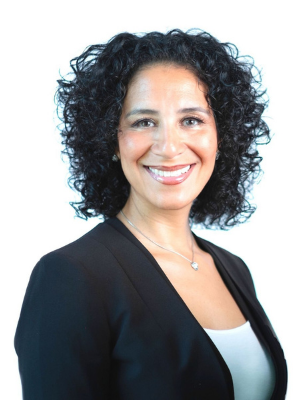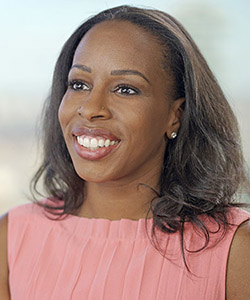 After sharing top tips on self-promotion from Latina leaders in business as part of our Hispanic Heritage month coverage, The Glass Hammer continues our two-part feature with more key insights from Latina leaders we’ve interviewed across the past years:
After sharing top tips on self-promotion from Latina leaders in business as part of our Hispanic Heritage month coverage, The Glass Hammer continues our two-part feature with more key insights from Latina leaders we’ve interviewed across the past years:
1. Value Those Who Show Up For You
If you want people to take personal interest in developing you, value the gift of energy and time they give, advised Cassandra Cuellar, Attorney at Shearman & Sterling.
“People are more than willing to have conversations with you when you show you appreciate their time,” said Cuellar. “Female partners whom I don’t even work with have reached out, which was so impressive that these busy women would welcome me and offer their support.”
Update: Cassandra Cuellar remains an Attorney in Shearman & Sterling’s Emerging Growth practice group, with the firm now for over 3.5 years.
2. Embrace the Learning Phase
You’re not expected to be an expert when you begin, emphasized Lina Woods, as Director, Global Digital Go-To-Market Leader at PwC.
“There were times of stress when I should have realized it was okay to learn along with everyone else,” realized Woods, ”and I see now that I could have harnessed that perceived vulnerability and realized you should just dive in and do your best.”
Update: With PwC for over five years, Lina Woods was appointed to Managing Director and Commercial Product Strategy Leader in June of this year.
3. Balance Intuition with Receptivity
Growing as a leader means both trusting yourself and being receptive to feedback, observed Priscila Palazzo, as Legal Director at WEX Latin America.
“While law might appear to be my main job, I also excel at understanding people and their behavior,” said Palazzo. “It’s important to be open to new ideas and thoughts, but especially to feedback. If you seek it out and reflect on it, it can help show you areas where you can grow and improve. As women, we tend to follow our hearts and intuition, but we need to balance that with feedback.”
Update: With WEX Brazil for over seven years, Priscila Palazzo is General Counsel.
4. Look Up And Around
You benefit hugely by looking up from your work and connecting, noted Anita Romero, General Counsel, Global Consumer at Citibank.
“When you’re first starting out, you’re so focused on doing excellent work that you don’t realize the many benefits of seeking advice from peers in your network,” said Romero. “People learn over time, but had I known that up front it would have really helped.”
5. Be Resilient With Your Vision
It’s easy to lose faith at obstacles, but Cristina Estrada, Head of Derivatives for the Latin America Financing Group, Investment Banking Division at Goldman Sachs, encouraged to keep the course.
“Pursuing what you are passionate about and chasing your dreams are key to having a successful career,” said Estrada. “Being patient is important though: there are ups and downs in everybody’s journey. Persistence and seeing beyond occasional difficulties pay off.”
Update: With Goldman Sachs for nearly 17 years, Cristina Estrada remains in her position.
6. View Detours As Opportunities
What appears as a career deviation may become your next adventure, guided Isela Bahena, Managing Director, Private Infrastructure Group at Nuveen Real Assets.
“It might seem scary, but looking back I see a lot of growth when I took those chances. There will be challenges, but sometimes the bridge is going to look different when you actually cross it,” said Bahena, known by junior colleagues for being calm amidst changes. “I tell them that’s because in the long run I always see them as opportunities.”
Update: With Nuveen Real Estates for over 3.5 years, Isela Bahena remains in her position.
7. Be The Change
Be the change the you wish to see, championed Elizabeth Nieto, as Global Chief Diversity and Inclusion Officer at MetLife.
“Women who have power can continue to push the envelope on women’s interests. We can complain about where we are or focus on what we’re achieving. Things may not be perfect in the corporate world, but we’ve accomplished a lot and we have to build from here,” encouraged Nieto. “Our daughters are watching us and making decisions about their lives based on how we make decisions about our own lives.”
Update: After nearly seven years at MetLife and a two year stint at Amazon, Elizabeth Nieto became Global Head of Equity and Impact at Spotify in March.
8. Create the Belonging
Women need to become aware of the barriers they impose upon themselves and invite each other in too, emphasized Yesi Morillo-Gual, as Founder and President of Proud To Be Latina.
“I started Proud To Be Latina because of some of the challenges I faced in my own career. These included things like not knowing how to navigate the landscape, not knowing about the unwritten rules, not having a lot of support, and also not really believing that I belonged because the majority of my colleagues did not look like me,” said Morillo-Gual. “There is a sense that we don’t belong, or that we have to leave who we are behind in order to advance our careers. We tend to question ourselves and our abilities.”
“I often hear women say that corporate America was not designed for them, and in response I tell them that corporate America may not have been designed for me, but I was designed for corporate America,” she added.
Update: Yesi Morillo joined Cushman & Wakefield as Director, Global Head of ERGs & External Partnerships in April.
9. Ask For Support
Getting past the notion of being the totally independent woman is hard but it’s also growth, shared Rosa Bravo, Business Development Director at Accenture, who started her career as an aerospace engineer.
“One of the things I wish I had known earlier is that it’s okay to ask for help. There are so many choices you have to make along the way, and you just can’t do it alone,” reflected Bravo. “I’ve been culturally conditioned to be a strong woman, to want to be able to do everything on my own. It took a few years to feel comfortable to raise my hand and ask for help when I needed it, but it made things much easier when I did.”
Update: Senior Technology Executive Rosa Bravo has been with Accenture for over 27 years.
10. Don’t Delegate Your Career Path
It’s important to design your own career rather than delegating that to your boss, asserted Valeria Strappa, as Head of Efficiency and Cost Management for Citi Latin America.
“What I think is important is to first be the designer of your own destiny and second, to learn that you might not necessarily get what you think you deserve, you will get what you are able to ask for and to sell for your results,” said Strappa. “A lot of times women think people will recognize their work. And they do, but that doesn’t mean you get what you were expecting for it. You have to be able to solve a big problem for a big leader and of course be able to stand up and show your results.”
Update: After a decade with Citi, Valeria Strappa has been with JPMorgan Chase & Co for nearly five years, and was appointed Managing Director – Head of M&A Integrations and Client Relationship Management in January 2020.
11. Embrace Change As a Catalyst
Change can be disruptive, but Elizabeth Diep, back when she was Senior Manager in PwC’s Asset Management Practice, challenged women to leverage it to advance their careers.
“Be open minded. There is such a changing landscape in this profession. We are seeing growth in Latin America, while in Europe, there are challenges now but absolutely something different is going to come out of it. It’s about being open to opportunities and not hesitating to take on new roles,” advised as Senior Manager, Asset Management Practice at PwC. “Every experience, whether good or bad, is going to help you grow. Don’t resist change. Change will help you become a seasoned professional a lot faster and a lot better.”
Update: Elizabeth Diep made Partner in 2013, and has been with PwC for over 21 years.
12. Leverage The Cultural Asset of Connectivity
Nellie Borrero, Managing Director, Senior Strategic Adviser of Global Inclusion and Diversity at Accenture, expressed that Hispanic women have an advantage in relationship building.
“We understand the advantage of relationships – it’s so embedded in our culture. That savviness and understanding of the importance of relationship building and maintaining relationships comes naturally to the Hispanic community,” asserted Borrero, who emphasized to network strategically: “And I would like to see young women do more of this: be able to reach out to the women at the top, and absorb that coaching and experience they can share. Become a sponge and absorb as much as you can. If they’re up there, they’ve found a way to make it work.”
Update: With Accenture for nearly 28 years, Nellie Borerro remains in her position.
13. Empower Yourself To Ask for What You Want
Twenty five years into her career, Marilyn Foglia, Managing Director and Head of Latin America at UBS Global Asset Management, realized it didn’t pay to be timid.
“I wasn’t always so persistent about getting my ideas on the table – but now I am!” Foglia declared. “If you’re too polite and wait for an opening to speak you may never get a voice. Don’t be afraid to ask for what you want. We women tend to think that if we work hard, we will be rewarded. But we have to ask for it.”
She encouraged women not to think of themselves as having less opportunities: “If you do that, you become afraid to voice your own opinion. Be sure to express your beliefs broadly. People will eventually hear you – that’s how you get recognized and move up the ladder.”
Update: With UBS for over 28 years, Marilyn Foglia remains in her position.
14. Find a Culture You Can Thrive In
Put the right environment at the top of your criteria when it comes to career-related decisions, advised Noelle Ramirez, Project Manager, Diversity, Equity & Inclusion at PGIM.
“Culture first. Seek out advice from people that are already there. What has their experience been? Do they feel comfortable? Do they feel like they can bring who they are to the table? If the answer is yes, that’s a good place to start. It takes away a lot of productivity and energy to not be who you are,” said Ramirez. “Go somewhere where you can be yourself. I’m very passionate in my delivery and it’s part of my culture. Making sure I’m in an environment where that doesn’t have to be shut off is important. Look for environments that are ready to receive you, because that’s where you’ll be your most productive, innovative, creative and strategic.”
Update: Interviewed earlier this year, Noelle Ramirez remains in this position, with PGIM for nearly 2.5 years.
We hope you enjoyed this two-part retrospective!
By: Aimee Hansen








